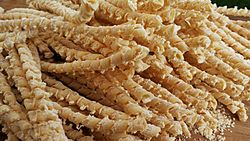Busiate facts for kids
 |
|
| Alternative names | Busiati, subioti, fusarioi, maccheroni bobbesi, busa, ciuffolitti (Abruzzo), gnocchi del ferro |
|---|---|
| Type | Pasta |
| Place of origin | |
| Region or state | Calabria, Sicily |
| Main ingredients | durum wheat, water |
| Variations | maccheroni inferrati (or firrichedi) |
Busiate (also called busiati) is a unique type of long pasta. It comes from the Trapani province in Sicily, Italy. This pasta is also very popular in Calabria.
Busiate gets its name from the word busa. This is a Sicilian word for the stem of a local grass called Ampelodesmos mauritanicus. This grass stem is used to help shape the pasta, giving it a cool spiral or twisted look.
Contents
What is Busiate Pasta?
Busiate pasta is known for its special twisted shape. It's made from simple ingredients like durum wheat and water. This pasta is a big part of the traditional food in Sicily and Calabria.
How Busiate Gets Its Shape
The unique spiral shape of busiate is made using a special tool. This tool is often a thin stick or a knitting needle. The pasta dough is wrapped around it to create the twists. There are two main ways busiate can be shaped:
- Busiate trapanesi: This type is made by wrapping a strip of pasta dough around a twig from the ampelodesmos grass. The pasta is coiled around the twig in a diagonal way.
- Maccheroni inferrati: This version is coiled vertically around a long, thin pin, like a knitting needle. Its shape is a bit like bucatini, which is another type of pasta with a hole in the middle.
Serving Busiate
Busiate pasta is often served with a delicious sauce called pesto alla trapanese. This sauce is a specialty from the Trapani region.
What is Pesto alla Trapanese?
Pesto alla trapanese is a fresh and flavorful sauce. It is made with simple ingredients that grow well in Sicily. These ingredients usually include:
This sauce is a perfect match for the twisted busiate pasta. The twists help to hold the sauce, making every bite full of flavor.


